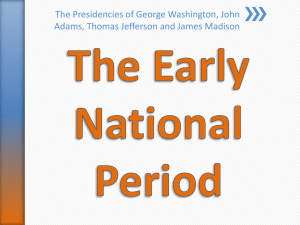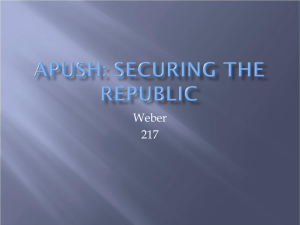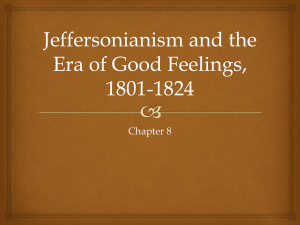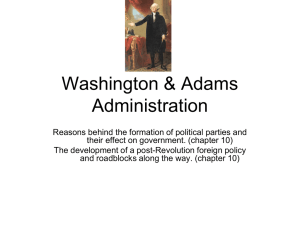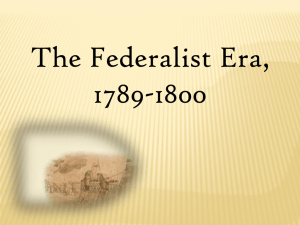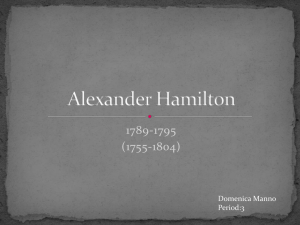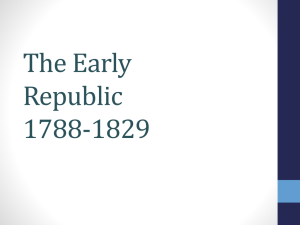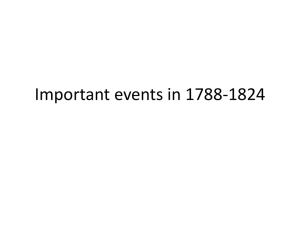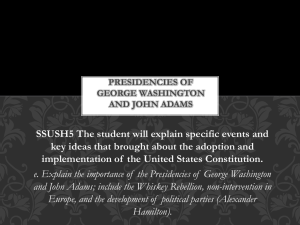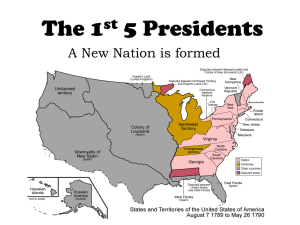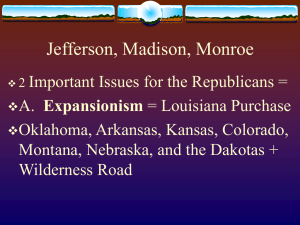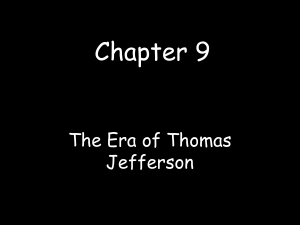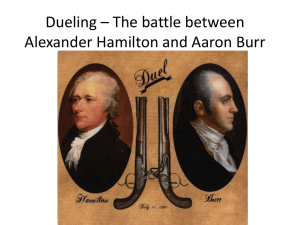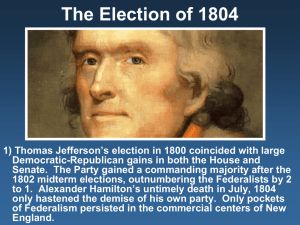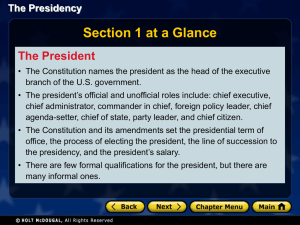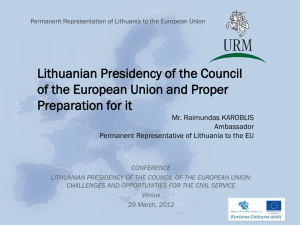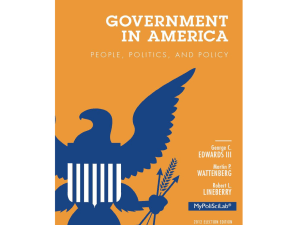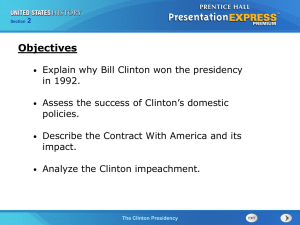VUS 6 a 1800 to 1850
advertisement
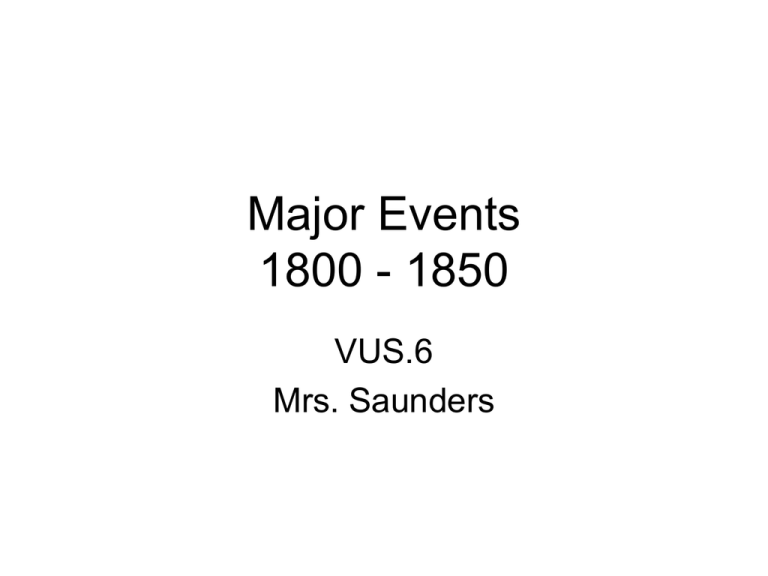
Major Events 1800 - 1850 VUS.6 Mrs. Saunders Go West Young Man! • Economic and strategic interests, supported by popular beliefs, led to westward expansion to the Pacific Ocean. • Prior to the Civil War U. S. experienced dramatic territorial expansion, immigration, economic growth, and industrialization. • The ideology of “Manifest Destiny” cause people to go to new frontiers. Washington’s Presidency President Washington Vice President John Adams Secretary of State Thomas Jefferson Secretary of War General Henry Knox Secretary of the Treasury Alexander Hamilton Washington’s Presidency The new government faced enormous debt. Alexander Hamilton proposed a two part plan for a national economic system including a national bank. • One made government responsible for all Revolutionary War debts, and funded that debt at its full value. • Second part, adopted over the strong objections of Madison and Jefferson, created a National Bank, to give the government some control of the money system. The Bank was a private stock corporation, but one-fifth of the members of its board of directors were to be appointed by the government. The dispute over the constitutionality of the Bank was a fundamental reason for the beginning of the first political party system. Washington’s Presidency • The French Revolution became an important domestic issue when France declared war against England in 1793 • The French position argued that the 1778 treaty that obligated the U.S. to support France against her enemies. • Hamilton argued that the treaty was with the French king, and did not apply. Jefferson believed the treaty was with the French people. Neither wanted war with England. • The French ambassador, Genét, angered possible supporters by recruiting Americans as privateers. •Washington received Genét coldly, and in the end proclaimed American neutrality. Washington’s Presidency Both the British and French were angered by the Proclamation of Neutrality and policy led to undeclared war with both. U.S. merchant ships were attacked by both. U.S. Soldiers were forced into “impressments”. John Jay, the first Supreme Court Chief Justice, was sent to England to negotiate what became Jay’s Treaty. Many politicians did not like it because it did not stop attacks on merchant ships and restricted trade. However, It did get the British to leave western forts and stop supplying Indians with weapons. Washington’s Presidency Part of Hamilton's plan to pay the Revolutionary War debt was to impose an excise tax on whiskey. In 1794 farmers in western Pennsylvania resisted tax collectors in the Whiskey Rebellion. President Washington led a force of 15,000 men to put down the rebellion but when he got there, there were no rebels to be found! The contrast between this rebellion and Shay’s rebellion is often used to show the effect of the Constitution and a strong central government. 1st Political Parties After George Washington’s presidency ended in the late 1790s, the first political parties emerged. • • • • The Federalists John Adams and Alexander Hamilton believed in a strong national government industrial economy supported by bankers and business interests in the Northeast • • • • Democratic Republicans Thomas Jefferson and James Madison believed in a weak national government agricultural economy supported by farmers, artisans, and frontier settlers in the South. John Adams’ Presidency • XYZ Affair - John Adams sent three ministers, Pinckney, Gerry and John Marshall, to Paris to try to negotiate an end to the Quasi-War with France. The French minister communicated with them through three underlings and demanded an enormous "bribe" from the Americans. The Americans refused to pay the bribe, and referred to the agents as "X, Y, and Z" in their report, thus naming the episode. John Adams’ Presidency • Alien and Sedition Acts – After the XYZ Affair, Anti-French feelings grew and many felt war with France was inevitable. In preparation for war, the Federalists passed the "Alien and Sedition Acts," providing for the deportation of enemy aliens and fining persons who criticized the government. Democratic-Republicans believed that the acts had the political purpose of silencing their party and was against the 1st amendment of Free Speech. The Election of 1800 • Tie between Aaron Burr and Jefferson. • Hamilton used influence to help Jefferson win in electoral college tie breaker • first presidential election in which power was peacefully transferred from one party to another. Won by Thomas Jefferson Burr kills Hamilton Aaron Burr and Alexander Hamilton dueled on July 11, 1804. Burr was still Vice President, although Jefferson had chosen a new running mate for that year's presidential election, when his quarrels with Hamilton reached a climax in April 1804. Hamilton had played a decisive role in Burr's defeat in the 1804 race for governor of New York. In the duel that resulted, Hamilton was killed, but the duel ended Burr's political career. Supreme Court under Chief Justice John Marshall • Marbury v. Madison established the power of the federal courts to declare laws unconstitutional (“judicial review”) • McCulloch v. Maryland prohibited the states from taxing agencies of the federal government (“the power to tax is the power to destroy”) Jefferson’s Presidency Meriwether Lewis William Clark • In 1803 Jefferson purchased Louisiana Territory from France • doubled the size of the United States. • He authorized the Lewis and Clark expedition to explore the new territories that lay west of the Mississippi River • Sacajawea, an Indian woman, served as their guide and translator. James Madison’s Presidency • James Madison elected President in 1808 • Secretary of State under Jefferson • Democratic Republican • Last “Founding Father” to become President. • Declares War on Britain War of 1812 Causes of the War: • Impressments (Britain took American sailors off of American ships and made them serve in the British navy.) • Freedom of the seas (The United States was being forced by both Britain and France to choose sides if the United States wanted to trade freely with either country) • The Embargo of 1807 (Jefferson decided to cut off all trade.This had a ruinous effect on the American economy.) "The President's House after the Conflagration of August 24, 1814." In order to cover up the smoke marks above the windows, the mansion was later painted white, which led to its being called the White House • The Barbary pirates (These were privateers in the Mediterranean Sea off • the coast of North Africa who were also trying to impede American shipping.) The Napoleonic Wars (In this ongoing European struggle between Britain and France, both countries wanted the United States to be on their side.) War of 1812 American incursions into the Indian territories in northern Ohio and Indiana had forced the Indians in that area to form a confederacy under the brilliant leadership of Tenskwatawa, and his brother, Tecumseh. The defeat of Tecumseh and his warriors at the Battle of Tippecanoe by the American general William Henry Harrison in November 1811 insured that the Indians would have to ally themselves with the English to survive during the War of 1812. The “War Hawks” in Congress wanted tyo push “on the Canada” War of 1812 • War of 1812 - American victory over the British • Treaty of Ghent ends war in Dec. of 1814 • produced an American claim to the Oregon Territory • increased migration of American settlers into Florida, which was later acquired by treaty from Spain in 1819. Battle of New Orleans – Andrew Jackson wins against the British The British had attempted to prevent American merchants from sending supplies to France, and had further angered the Americans by "impressing" seamen from American ships. These led to the War of 1812, in which the Americans again fought off the British, ending the conflict between the two countries. Actually, this battle (the Battle of New Orleans) took place after the U.S.-British negotiators had signed the terms of peace in Ghent. War of 1812 Francis Scott Key described the scene of the British bombardment of the Fort in his stirring poem, The Star Spangled Banner, published in Baltimore and widely distributed as a song sung to a popular drinking ballad tune, Anacreon in Heaven. The tune and its verses were not adopted as the national anthem until 1931. James Monroe’s Presidency • James Monroe become President in 1816 • Democratic-Republican • James Madison’s Secretary of State & Secretary of War • Federalist Party dies out • Starts the “Era of Good Feeling” The Monroe Doctrine (1823) • The American continents should not be considered for future colonization by any European powers. • Nations in the Western Hemisphere were inherently different from those of Europe, republics by nature rather than monarchies. • The United States would regard as a threat to its own peace and safety any attempt by European powers to impose their system on any independent state in the Western Hemisphere. • The United States would not interfere in European affairs Go West Young Man! • The belief that it was America’s “Manifest Destiny” to stretch from Atlantic to Pacific provided political support for territorial expansion. • American settlers poured westward from the coastal states into the Midwest, Southwest, and Texas, seeking economic opportunity in the form of land to own and farm. Go West Young Man! • The growth of railroads and canals helped the growth of an industrial economy and supported the westward movement of settlers. • Eli Whitney’s invention of the cotton gin led to the spread of the slaverybased “cotton kingdom” in the Deep South. Don’t Mess with Texas! • American migration into Texas led to an armed revolt against Mexican rule and a famous battle at the Alamo. • The Texans’ eventual On March 1, 1836, Texas declared itself independent. Mexican President Santa victory over Mexican Anna arrived in San Antonio in March 1836 with an inexperienced and poorly forces subsequently equipped army. He called for the brought Texas into the surrender of the Alamo, but its defenders, none of whom was TexasUnion. born, refused and were martyred. Don’t Mess with Texas! • The American victory in the Mexican War during the 1840s led to the acquisition of an enormous territory that included the present-day states of California, Nevada, Utah, Arizona, and parts of Colorado and New Mexico. Policy of Indian Removal • Conflict between American settlers and Indian (First American) nations in the Southeast and the old Northwest resulted in the relocation of many Indians (First Americans) to reservations. Go West Young Man! • During this period of westward migration, the American Indians were repeatedly defeated in violent conflicts with settlers and soldiers and forcibly removed from their ancestral homelands. • They were either forced to march far away from their homes (the “Trail of Tears,” when several tribes were relocated from Atlantic Coast states to Oklahoma) or confined to reservations. Indian Removal Act of 1830 All the major tribes in the South would be forced by Andrew Jackson and the American militia forces to give up extensive lands, preparing the way for the Jacksonian era Indian removals that culminated in the " Trail of Tears ." The Cherokee fought back and took their case to the Supreme Court with the help of a Christian Missionary. In Worcester vs. Georgia, John Marshall ruled the federal government could not seize Cherokee land but Jackson refused to abide by the decision saying, “John Marshall has made his decision; not let him enforce it”. The forcible removal of the American Indians (First Americans) from their lands would continue throughout the remainder of the nineteenth century as settlers continued to move west following the Civil War. Women’s Rights The women’s suffrage movement grew during the same time as the abolitionist movement. The first Women's Rights Convention was in 1848 at Seneca Falls, NY, where the American feminist movement was launched. presenting a "Declaration of Sentiments" which echoed the Declaration of Independence. At this meeting, 61 women and 34 men, most of them veterans of the antislavery movement, demanded the right for women to vote. A cartoon representing feminist speaker denouncing men Women’s Rights Elizabeth Cady Stanton and Susan B. Anthony (standing), who became involved in women’s suffrage before the Civil War, and continued with the movement after the war. In the 1870s and 1880s, Susan B. Anthony and her long-time partner Elizabeth Cady Stanton formed the National Woman Suffrage Association in Washington, D.C. in 1869, and published a newspaper The Revolution, which called for both enfranchisement for women, and equal pay for women, for child care centers, and more equitable divorce laws.
